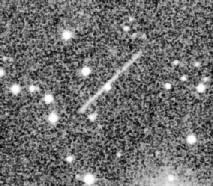To find FMOs, you need to stare at an image and look for trails. The longer the trail, the faster the object is moving. The example below is of asteroid 1994 XM1, 12 hours prior to passing between the Earth and the Moon! The net distance moved is about 1/20 of the diameter of the moon in 2.5 minutes.

Your challenge is separating what SPACEWATCH® would consider an interesting FMO from image flaws (cosmic rays, bad CCD columns and diffraction spikes) and spurious FMOs (FMOs with a geocentric orbit, e.g. satellites.)
Armed with your new knowledge on separating a reportable FMO from stationary objects, image flaws and unrecoverable objects, try the following test (same test as the quiz linked to the end of the tutorial.)
Feeling confident about your FMO diagnosing skills? You are now ready to try finding FMOs in real SPACEWATCH® mosaic data. Note that an interesting FMO is a rare find, we expect to see fewer than 5 interesting FMOs in SPACEWATCH® data per month.
We have provided a detailed explanation of the steps taken to find and designate FMOs. Please visit Image Process flow page by clicking below button.

